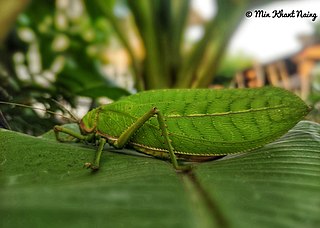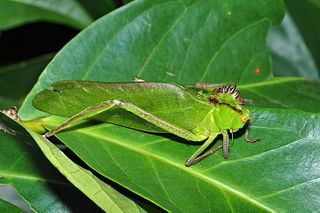
Conocephalus is a genus of bush crickets, known as coneheads. It was described by Carl Peter Thunberg in 1815.

The subfamily Pseudophyllinae contains numerous species in the family Tettigoniidae, the katydids or bush crickets. Sometimes called "true katydids", together with the crickets of suborder Ensifera, they form part of the insect order Orthoptera which also contains grasshoppers.

The Phaneropterinae, the sickle-bearing bush crickets or leaf katydids, are a subfamily of insects within the family Tettigoniidae. Nearly 2,060 species in 85 genera throughout the world are known. They are also known as false katydids or round-headed katydids.

Meconematinae is a subfamily of the bush crickets, with a worldwide distribution.

Mecopodinae are a subfamily of bush crickets found in western South America, sub-Saharan Africa, and Asia. In Asia, the distribution includes India, Indochina, Japan, the Philippines, and Malesia to Papua New Guinea and Australasia, including many Pacific islands.

The Copiphorini are a tribe of bush crickets or katydids in the family Tettigoniidae. Previously considered a subfamily, they are now placed in the subfamily Conocephalinae. Like some other members of Conocephalinae, they are known as coneheads, grasshopper-like insects with an extended, cone-shaped projection on their heads that juts forward in front of the base of the antennae.

Typophyllum is a genus of Neotropical, leaf-mimicking katydids or bush crickets belonging to the subfamily Pterochrozinae.

Conocephalinae, meaning "conical head", is an Orthopteran subfamily in the family Tettigoniidae.

Agraeciini is a large tribe of bush crickets or katydids in the conehead subfamily, Conocephalinae.

Copiphora rhinoceros, the rhinoceros katydid, is a relatively large, up to about 7.5 cm (3 in) long, species of katydid found in Central America. It belongs to a group known as the conehead katydids, several of which have a horn-like projection on the top of the head. The horn of the rhinoceros katydid is used to ward off attacks from hungry bats. Unlike most katydids, which are herbivores, the rhinoceros katydid is an omnivore, feeding on fruit, seeds, flowers, invertebrates, frog eggs and small lizards. The species can be quite noisy during the night and produces one of the dominant sounds in Central American lowland forests. Its lifespan is one to two years.
Capnogryllacris is a genus of leaf-rolling crickets in the subfamily Gryllacridinae and tribe Capnogryllacridini. Species are found in Far East and South Asia, which includes those previously placed in the obsolete genus Borneogryllacris.

Neoconocephalus is a genus of katydids or bush crickets in the tribe Copiphorini, from the Americas.

Orchelimum is a genus of katydid with 21 known species.

The Pterochrozinae are a subfamily of the Tettigoniidae found in Central and South America. They were previously placed as a tribe in the subfamily Pseudophyllinae and have been called "leaf-mimic katydids".

The Listroscelidinae are a subfamily of the Tettigoniidae found in the Americas, Madagascar, and Australia. The genus Arachnoscelis has become better known to the public after being featured on the cover of Science in 2012.

Romaleinae is a subfamily of lubber grasshoppers in the family Romaleidae, found in North and South America. More than 60 genera and 260 described species are placed in the Romaleinae.
Pyrgocorypha is a genus of coneheads in the family Tettigoniidae. There are about 16 described species in Pyrgocorypha, found in the Americas, southern and eastern Asia.
Pterophyllini is a tribe of true katydids in the family Tettigoniidae. There are about 16 genera and more than 40 described species in Pterophyllini.

Moncheca is a genus of relatively large, colorful conehead katydids in the tribe Copiphorini, native to the Neotropics.

Steirodon is a genus of large phaneropterine katydids in the family Tettigoniidae, native to tropical and subtropical forests in South America, Central America and Mexico.
















